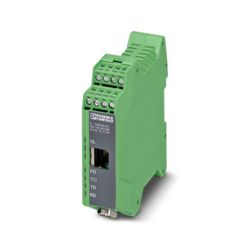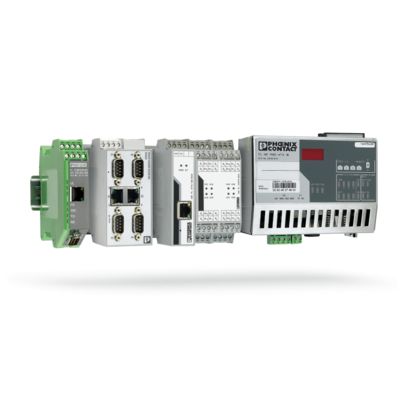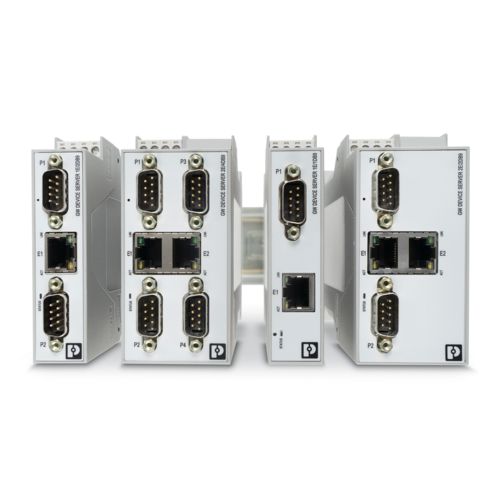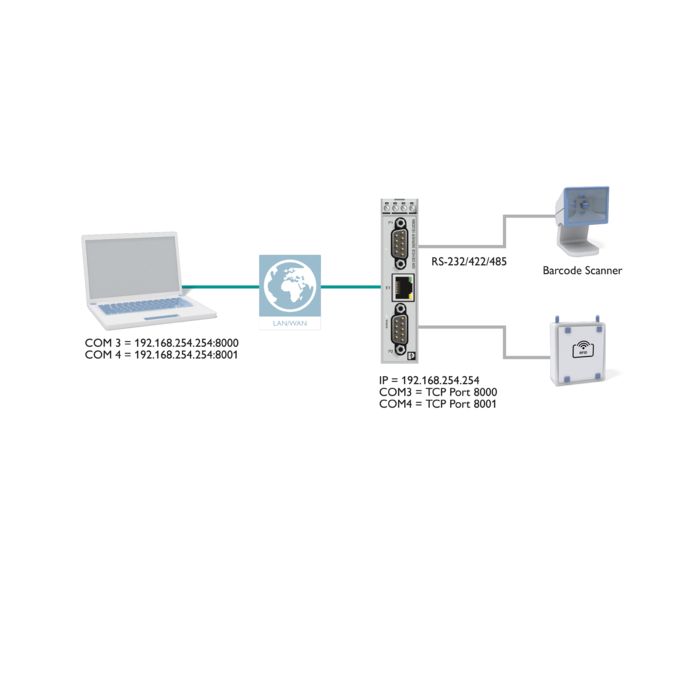
Second generation FL COMSERVER UNI..., serial device server for converting a serial 232/422/485 interface to Ethernet, supports TCP, UDP, Modbus gateway, and PPP applications, incl. COM port redirector software and user documentation


Use device servers to convert serial interfaces such as RS-232, RS-422, and RS-485 to other standards, such as Ethernet (RJ45), with protocol transparency. Gateways and protocol converters convert various fieldbus and Ethernet protocols (e.g., PROFIBUS to PROFINET), thus enabling the easy integration of legacy serial devices and fieldbuses into modern Ethernet networks.

Second generation FL COMSERVER UNI..., serial device server for converting a serial 232/422/485 interface to Ethernet, supports TCP, UDP, Modbus gateway, and PPP applications, incl. COM port redirector software and user documentation

USB HART modem cable for communication between a PC and HART devices, cable length: 1 m.

GNSS receiver and NTP (Network Time Protocol) time server for Ethernet networks, receives time, date, and location via GPS, Galileo, GLONASS, and BeiDou, web-based management, supply via PoE (af) or 24 V DC, integrated antenna, IP68 housing

The GW MQTT/MODBUS… gateway enables two-way data transfer between serial or Ethernet Modbus devices and an MQTT broker. Includes one RJ45 port and one D-SUB 9 port.

The GW MQTT/MODBUS… gateway enables two-way data transfer between serial or Ethernet Modbus devices and an MQTT broker. Includes two RJ45 ports and four D-SUB 9 ports.

The GW MQTT/MODBUS… gateway enables two-way data transfer between serial or Ethernet Modbus devices and an MQTT broker. Includes two RJ45 ports and two D-SUB 9 ports.

The GW MQTT/MODBUS… gateway enables two-way data transfer between serial or Ethernet Modbus devices and an MQTT broker. Includes one RJ45 port and two D-SUB 9 ports.

Proxy for PROFINET-RT-IRT, G4 functionality, INTERBUS proxy with integrated 4-port switch

The GW MODBUS TCP/RTU... gateway converts serial based Modbus RTU (or ASCII) to Modbus TCP. Supports serial client or server devices. Includes one RJ45 port and one D-SUB 9 port.

Second generation FL COMSERVER BASIC..., serial device server for converting a serial RS-232/422/485 interface to Ethernet, only supports TCP and UDP applications, incl. Com Port Redirector software and user documentation (PDF)

Serial device servers: overview of versions
Serial device servers enable the easy integration of legacy serial devices and buses into modern Ethernet networks.
Many applications involve multiple serial devices in close proximity, such as bar code scanners and printers. All the devices have to be connected to Ethernet. In this case, using a multi-port converter saves money and valuable space in the control cabinet.
Furthermore, the application can be customized to allow different users to access different serial interfaces via a single converter.

Virtual COM port application with PC and serial devices
The serial device servers of the GW DEVICE SERVER... series are used to connect standard serial devices (usually with RAW or ASCII file formats) to Ethernet networks. The devices can be used as a “virtual COM port” or as a native TCP or UDP Ethernet device.

Integration of any ASCII protocol into Modbus or EtherNet/IP™
Modules of the GW MODBUS TCP/RTU... series are used to convert Modbus/RTU (or ASCII, serial) to Modbus/TCP. You can configure these high-performance modules for any combination of Modbus client and server.
Modules of the GW MODBUS TCP/ASCII... series can be used to make serial RAW or ASCII strings from devices such as bar code scanners, scales, or RFID tags available via the Modbus protocol. You can convert these strings to EtherNet/IP™ using modules belonging to the GW MODBUS EIP/ASCII... series.

Integrate any Modbus devices into the EtherNet/IP™ protocol
You can integrate Modbus servers into the EtherNet/IP™ protocol using modules from the GW EIP/MODBUS… series. This allows you to integrate existing Modbus devices into the widely used Ethernet-based EtherNet/IP™ protocol.

Integrate any Modbus device into IIoT applications using MQTT
Bridge the gap between IOT and industrial control systems with the GW MQTT/MODBUS... series. Connect Modbus clients and servers to the local or the cloud broker of your choice. Web-based management makes configuration simple with no programming required. Support for default MQTT and Sparkplug B provides flexibility for integration into IOT applications.

High-performance access to HART signals via Ethernet
The modules of the GW PL… series consist of a front module and up to five extension modules. These modules allow the easy parameterization and monitoring of HART field devices via Ethernet networks.
Ethernet is connected via HART-IP, Modbus/TCP, or PROFINET. You can connect up to 40 devices with the modular HART Ethernet gateway.

NAMUR Open Architecture
The GW PL ETH/UNI head station communicates via OPC UA in accordance with the NAMUR Open Architecture (NOA) concept. Here, the device acts as a data diode for forwarding diagnostic data and process data from HART field devices to any cloud system.
Process efficiency is monitored through analysis and processing of the data gathered. When necessary, the information is fed back to the ERP system, for example to automatically generate maintenance orders. This configuration does not affect or endanger the process-driving systems.

Proxy for INTERBUS
Do you want to integrate an INTERBUS application into a PROFINET network? Then the FL NP PND-4TX IB is the ideal solution. Simply parameterize the device using your go-to programming tool. You can use the integrated switch in the control cabinet as an uplink to the control system or in the field for series connection.

Proxy for PROFIsafe
One of a kind: consistent PROFIsafe communication across network boundaries.
The PROFIsafe gateway from Phoenix Contact allows secure communication between two PROFINET networks. This means that you can implement functional safety, such as emergency switch-off concepts, across systems and manufacturers.

Industrial time server for Ethernet networks
The FL TIMESERVER NTP industrial time server makes time information available in the Ethernet network via NTP protocol. The time is received via GPS, GALILEO, or GLONASS independently of other NTP services and without an Internet connection. With the robust IP68 housing with integrated antenna and PoE supply, you can install the device outdoors without any problems.

Ethernet HART gateway
Depending on the application, serial RS-485- or Ethernet-based access to all the digital data from HART devices is possible.
The Ethernet HART gateway provides PROFINET, Modbus TCP/IP, and HART-IP access to 40 devices. Each device connection has its own HART master that allows it to forward HART data as fast as possible via Ethernet.
When using a Modbus TCP/IP network, it is also possible to provide four digital inputs and four digital outputs.